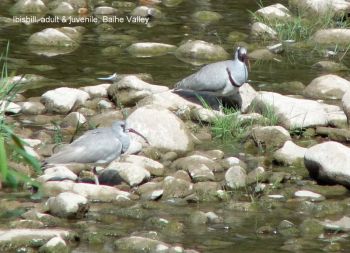- Ibidorhyncha struthersii
Identification
39–41 cm, 15.4-16.1 inches, wingspan 74 cm, 34.3 inches. 270–320 g, 9.5-11.3 oz
Adult
- Grey-brown upperparts
- White underparts
- Black face, crown with a narrow white border and white ear-coverts
- Remainder of head and neckpale bluish-grey
- Black breast band with narrow white band above
- Short tail with incomplete dark, narrow terminal band
- feet do not extend beyond tip of tail in flight
- Wings mainly grey with variable white patch on inner and central primaries with a narrow white band on the outer primaries
- Greyish-purple to red legs
- Long decurved brown to deep red beak (68-82 mm, 26.8-32.3 inches)
- Female similar to male, but slightly larger with slightly longer beak
- Non-breeding adult has white-streaks on a black face
Juveniles
- Browner with less well defined plumage pattern
- Dark brown breast band
- Grey speckled face
- Upperparts have pale fringes
- Duller colours on bare parts
Immature
- Plumage almost inseparable from that of adult, except for darker red base of beak
- A few brown feathers in upperparts and sometimes keeps a mainly white face for several months
Chicks
- Greyish down with darker black and brown markings
- Long brownish beak, 18 mm, 7.1 inches
Distribution
Central Asia and the Himalayas.
Asia: found in Turkestan, Kazakhstan, Uzbekistan, Turkmenistan, Kyrgyzstan, Tajikistan. China and Nepal
South Asia: Pakistan, India and Bhutan
Southeast Asia: Indochina and Myanmar
Taxonomy
This is a monotypic species.
Habitat
Breeds in gravelly mountain river valleys normally lacking any vegetation, from 500 to 4400 m. Recently discovered nesting at just 270 m near Beijing, China.
Is found at similar habitats in winter, but at lower altitudes, sometimes as low as 100 m.
Behaviour
Diet
Primary diet is aquatic river invertebrates and fish, including stoneflies (Plecoptera), larvae of mayflies (Ephemeroptera), caddisflies (Trichoptera), beetles (Carabidae) and crustaceans. In western Sichuan (China), in winter, main factors relating to feeding site selection were stones with a diameter of > 30 cm, size of river islands, river width and width of bank.
A study found nine types of food, with feeding mostly on caddisfly larvae (37·72% ± 12·96%), stonefly larvae (36·36% ± 6·06%) and crustaceans (17·76% ± 7·74%). Forages by pecking, probing and raking, wading in belly deep water.
Forages singly, rarely in pairs and loose flocks of up to 12 birds have been seen in winter, exceptionally up to 27 (in Bhutan). A late summer and midwinter study in Sichuan found that foraging (48.9%) and resting (32.3%) were the most commonly observed behaviour, with foraging time significantly higher in winter.
Breeding
Nest is a shallow scrape on the ground, occasionally lined with pebbles.
Laying normally starts at the end of April and is thought to continue for some time, with hatching from mid-May to late June (Tien Shan, Himalayas, China), but apparently much earlier, even late March in parts of Bhutan. Monogamous and territorial, with territories occupied for years. Breeding season density of one pair per km recorded at Punakha, Bhutan.
Normally four eggs, but completed clutches of two and three eggs have been recorded. Incubation by both sexes. Fledged at 45–50 days and the chicks are thought to stay with parents until the first winter.
Movement
Altitudinal migrant. Descends in winter, in Himalayan zone to as low as 100 m. In western Sichuan (China) found throughout January – March at 3715–4200 m. Return to breeding areas usually starts in March. The has been some initial post-breeding dispersal to higher altitudes, descending later in autumn. In some areas of Bhutan, at 2200–2800 m, the species appears to be resident, staying mainly within breeding range all year, but also reaches northern Myanmar during this season.
Vocalisation
Call: a ringing Klew-klew reminiscent of a Common Greenshank, especially for younger birds.
Flight-call is a Common Sandpiper-like “sissi-sip, sissi-sissi-sip”
References
- Clements, J. F., P. C. Rasmussen, T. S. Schulenberg, M. J. Iliff, T. A. Fredericks, J. A. Gerbracht, D. Lepage, A. Spencer, S. M. Billerman, B. L. Sullivan, and C. L. Wood. 2023. The eBird/Clements checklist of Birds of the World: v2023. Downloaded from https://www.birds.cornell.edu/clementschecklist/download/
- Avibase
- Handbook of the Birds of the World Alive (retrieved December 2016)
Recommended Citation
- BirdForum Opus contributors. (2024) Ibisbill. In: BirdForum, the forum for wild birds and birding. Retrieved 27 April 2024 from https://www.birdforum.net/opus/Ibisbill
External Links
GSearch checked for 2020 platform.1






